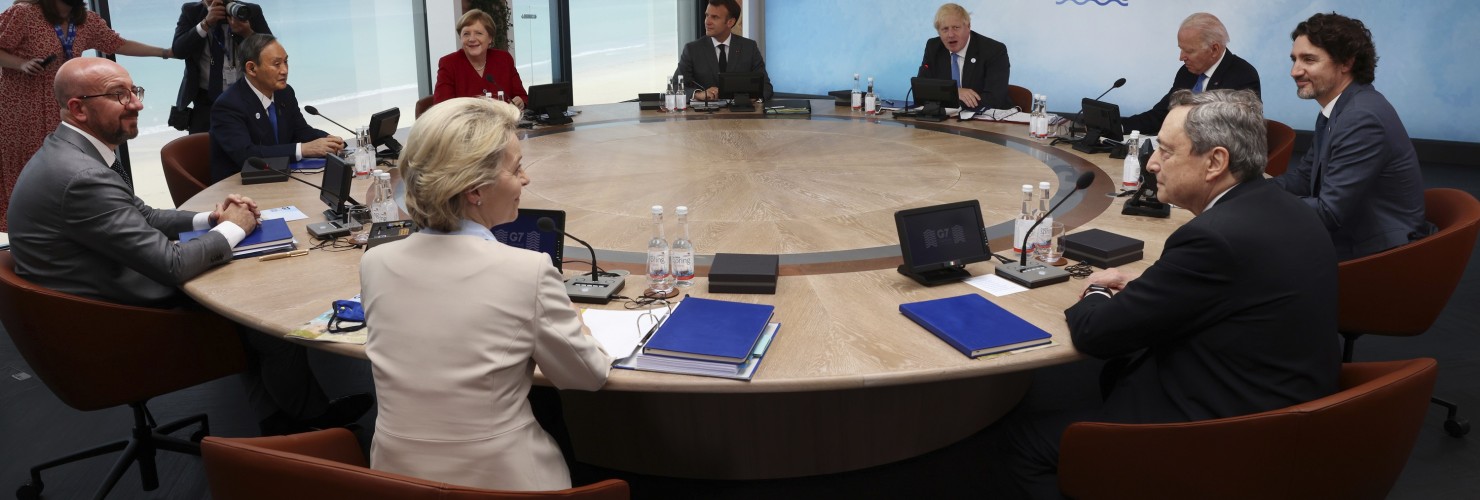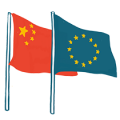

International summits focus on China + Beijing's anti-sanctions law
EU-US summit initiatives strengthen prospects for transatlantic China coordination
On June 15, the EU and the US held a summit bringing together Presidents Ursula von der Leyen, Charles Michel and Joe Biden. The summit statement covered a range of key points related to China.
Summit outcomes
- Trade and Technology Council (TTC): The council was established as a bilateral platform for coordination on tech and trade policies as well as a cooperation with liked-minded countries on a “democratic model of digital governance.” The TTC will initially be made up of working groups tackling multiple issues including tech standards, green tech, ICT security and critical supply chains. The EU and the US also plan to launch a Joint Technology Competition Policy Dialogue and a Green Technology Alliance.
- China policy: Both sides agreed to consult and cooperate their respective China policies, pursuing a multi-faceted approach that includes “cooperation, competition and systemic rivalry.” The statement also echoed the G7 communique on concerns regarding Xinjiang, Hong Kong, Tibet, the Taiwan Strait, as well as the East and South China Sea.
- Trade: The EU and the US plan to work jointly on updating the WTO rulebook to address “industrial subsidies, unfair behaviour of state-owned enterprises.” The two sides introduced a five-year suspension on tariffs linked to the major Airbus-Boeing subsidies dispute.
- Democracy: Transatlantic cooperation will advance democratic values and uphold the “rules-based international order.” Both sides “reject authoritarianism in all its forms around the globe” and plan to enhance cooperation on related sanctions.
- Security: The two sides plan to launch a dedicated security and defense dialogue and coordinate measures to counter disinformation.
Quick take
The outcome of the summit may bode well for transatlantic cooperation on China, if the new technical frameworks are used effectively. The TTC could become a key channel to constructively address some of the systemic challenges posed by China. The divergences on political pressure towards China remain in place as shown by the US inserting language such as “addressing shared challenges from China” into their fact sheets on the Airbus-Boeing dispute, which the European side did not include in their release on the issue.
Read more
- European Council: EU-US Summit statement: "Towards a renewed Transatlantic partnership"
- Reuters: U.S, EU agree truce in 17-year aircraft subsidy conflict
- Mission of the PRC to the EU: Spokesperson of the Chinese Mission to the EU speaks on a question concerning the EU-US summit statement
China looms over G7 summit
The G7 leaders met last week for a summit in Cornwall. Joined by counterparts from Australia, India, South Africa and South Korea, the leaders addressed multiple issues linked to China.
Summit outcomes:
- Global infrastructure partnership: Discussions continue on the creation of an infrastructure development partnership as an “alternative to the Belt and Road Initiative.” The partnership is to be values-driven, market-led and sustainable. A dedicated taskforce is to develop practical proposals by autumn.
- Foreign policy: Leaders echoed points from the May G7 Foreign Ministers statement. They expressed their concerns over developments in Xinjiang, Hong Kong, the Taiwan Strait, the East and South China Sea and stated their support for a “free and open” Indo-Pacific.
- Economic policy: The G7 plans to develop “collective approaches to challenging non-market policies” with explicit mention of China. G7 are also to coordinate on addressing forced labor “of vulnerable groups and minorities” in supply chains with G7 Trade Ministers expected to identify cooperation areas by their October meeting.
- Digital governance: Leaders voiced their support for a human-centric digital ecosystem and preserve an open, interoperable internet. Such ambitions run counter to China’s approach to digital sovereignty. More to be discussed at the ‘Future Tech Forum’ in September.
- Covid-19 origins: The G7 called for a transparent, scientific investigation, including in China.
Quick take
The G7’s final communique, peppered with indirect references to China’s activity, serves as a political mission statement to uphold a vision of international order challenged by China’s rise. Such framing fuels Beijing’s narrative of encirclement and is likely to solidify its defensive approach. However, the new infrastructure partnership still lacks details regarding implementation or funding, but the US administration is keen to present it as an “alternative to the BRI”. It is the technical process of turning the statements actionable that will define the impact of this G7 summit and will show whether the divergences on China can be effectively mitigated.
Read more
NATO labels China’s activity a “systemic challenge” for the first time
On June 14, NATO leaders gathered for a summit in Brussels and agreed on the alliance’s 2030 agenda. Their discussions involved developing a common position on China.
Summit outcomes
- Systemic challenge: For the first time, a NATO communique identified China’s ambitions and activities as “systemic challenges to the rules-based international order and to areas relevant to Alliance security.”
- Security concerns: The communique expressed concerns over China’s buildup of military capabilities (oftentimes through untransparent civil-military fusion) and its military coordination with Russia including joint exercises in the Euro-Atlantic area. It also pointed at cyber, hybrid and asymmetric threats such as disinformation campaigns and deployment of coercive policies.
- Dialogue: The document called for maintaining a constructive dialogue on areas such as climate change and arms control and highlighted the value of information exchanges with China.
- EU-NATO: The cooperation was lauded as extensive in areas such as resilience building, emerging tech, the security implications of climate change and countering disinformation.
- China’s response: On June 15, the Chinese Ministry of Foreign Affairs criticized the summit as an example of US efforts to “form small cliques against China with ideology as the yardstick.” Beijing hopes the EU’s policy “won't be hijacked by other country's wrong China policy.” We will analyze Chinese debates on this week’s summits in the upcoming edition of the MERICS EU-China Briefing.
Quick take
NATO’s strongly worded statement on China is testament to the growing concerns about Beijing’s activity on both sides of the Atlantic. Still there is no clear consensus whether NATO is the right platform to tackle non-security challenges posed by China. President Macron argued that within NATO’s cooperation on China “we shouldn’t confuse our goals”. He pointed to the complexity of the relationship with Beijing, and for multiple European actors Russia remains the focus of the alliance.
Read more
European companies face legal dilemma over Sanctions Law
On June 10, the Standing Committee of the National People’s Congress approved a new sanctions law, which provides China with a legal framework to counter punitive legal measures by external actors. The law puts European businesses in a challenging position.
What you need to know
- The sanctions law was developed as a response to American measures targeting Chinese entities, yet it would apply to European and other actors. The retaliatory measures deployable under the law align with the countersanctions imposed by China in March on the EU and other actors that coordinated of sanctions on Xinjiang.
- The European companies will find article 12 particularly challenging, as it forbids organizations and individuals to “enforce or assist in enforcing the discriminatory restrictive measures employed by foreign nations against our nation's citizens or organizations.” Failure to comply may result in companies being forced to compensate any losses to Chinese entities but the vagueness of the article leaves room for more interpretation.
- It remains to be seen how the law will be implemented and whether it will extend to what China considers ‘politically sensitive’ European regulations. For example, just a day later, on June 11, the German Parliament passed a supply chain act, which will oblige companies to investigate their supply chains for abuses of human rights, forced labor or environmental breaches. The act will be gradually implemented from 2023 onwards.
Quick take
The sanctions law provides China with the legal foundation for both retaliatory responses and offensive measures. It is a part of a wider effort by Beijing to create legal tools to fend off external pressures and build up its capacity to use lawfare. Other recent endeavors include countersanction regulations by the Ministry of Finance and the publication of a list of unreliable companies. So far Beijing has not put these measures into practice, but should it decide to enforce the new law, companies may find abiding the European or US regulations incompatible with the new Chinese legislation.
Read more
Short takes
Italy’s confusing Belt and Road Initiative involvement
At G7, Italian Prime Minister Mario Draghi indicated plans to review involvement in BRI. Yet leaked Italian MFA documents suggest that he will discuss with Premier Li Keqiang for deeper implementation of Italy’s 2019 BRI agreement.
Czech Senate names China’s Xinjiang policies a genocide
On June 10, the Senate passed a resolution calling for a boycott of the Beijing Winter Olympics.
- Senate of the Czech Republic [CZ]: Resolution on the 2022 Olympic Games in the PRC and the commitments of the host country
Romanian president signs bill to ban Huawei from 5G
On June 11, Romania passed a law which effectively bars Huawei from constructing 5G infrastructure in the country. On June 14, Albania signed an agreement with the US on 5G coordination.
- Reuters: Romanian president signs bill into law to ban Huawei from 5G
- Euractiv: US, Albania sign 5G tech coordination agreement
Finland updates its China policy
In its “China Action Plan,” Helsinki calls for a more assertive policy.
- Ministry of the Foreign Affairs of the Republic of Finland [FI]: Finnish State Administration's China Action Plan 2021
Brussels asks national banks to help Montenegro ease burden of China debt
EU officials asked German, French and Italian state lenders to provide financial aid to Montenegro struggling with Chinese credit for highway construction.

